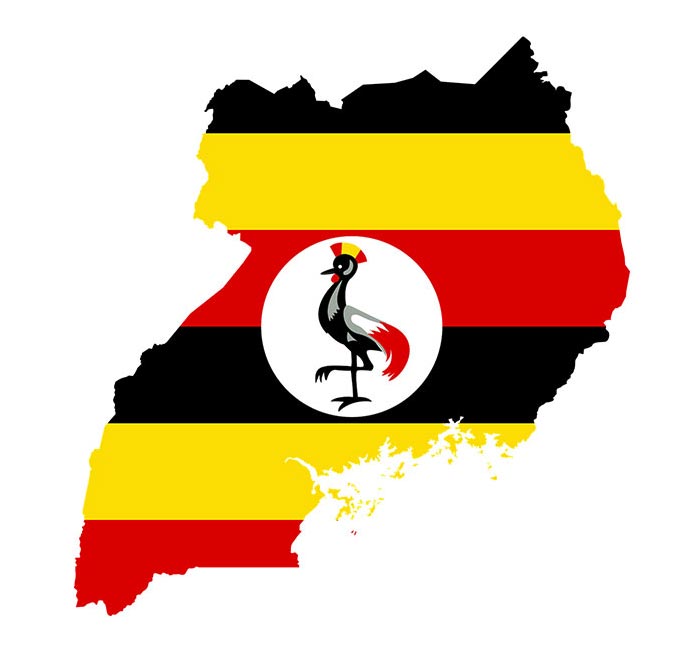Basic Facts

Geography and location
Uganda, commonly known as the ‘Pearl of Africa,’ lies astride the Equator. From North to South, it is located between latitudes 4°12' N and 1°29' S. From West to East, it lies between longitudes 29°34' E and 35°0' E.
It covers an area of 241,038 square kilometers, of which about a third is covered by fresh water bodies and wetlands. It is mainly a plateau astride the equator, with favorable tropical climate and average temperature ranging from 18 to 28 degrees centigrade. (Source: Vision 2040)
Located in Eastern Africa, Uganda is a landlocked country, bordered by: Kenya to the East, South Sudan to the North, Democratic Republic of the Congo to the West, Rwanda to the Southwest and Tanzania in the South. The south-eastern part of the country is covered by a substantial portion of Lake Victoria, which is shared – at varying portions – with Kenya and Tanzania.
In addition to Lake Victoria (the second largest fresh water lake in the world), Uganda is the source of River Nile – the longest freshwater river n the world, covering a distance of 6650 kms. Other major physical and geographic features include: the snow-capped Rwenzori Mountain ranges in Western Uganda; and Mountain Elgon in the East. At 4,000km², Mt. Elgon has the largest volcanic base in the world, and is the oldest and largest solitary, volcanic mountain in East Africa
Independence
Uganda attained her Independence from British colonial rule on 9th October, 1962.
Capital City
Kampala
Other Cities
Mbarara, Gulu, Jinja, Fort Portal, Masaka, Lira, Soroti, Hoima (UBoS)
Population
43.7 Million (UBoS: 2022 projections)
Brief History

Uganda became a British Protectorate in 1894 and was formed by bringing together a number of kingdoms, notably Buganda, Bunyoro, Toro, Busoga, Ankore and several chieftaincies. Uganda became independent from British colonial rule on 9th October 1962.
Since independence, Uganda has gone through various political changes. The immediate post-independence government was led by Sir Edward Mutesa II as the first (non- executive) President (1962- 1966), followed by Apollo Milton Obote (1966- 1971), Idi Amin Dada (1971- 1979), Yusuf Kironde Lule (1979), Godfrey Lukongwa Binaisa (1979- 1980), Paul Muwanga (1980), Apollo Milton Obote (1981- 1985), Tito Okello Lutwa (1985- 1986) and Yoweri Kaguta Museveni (1986 to date).
Under the Leadership of His Excellency Yoweri Kaguta Museveni, the National Resistance Movement (NRM) government has revitalized the country, providing political stability, a growing economy, macroeconomic stability and an improved infrastructure.
Government
Uganda is a multiparty democracy and Unitary State comprised of three arms, namely:
National Symbols
National Flag
The Uganda flag is composed of six (6) horizontal stripes alternating black, yellow and red. Black symbolizes our African heritage and the fertile soils of Uganda; Yellow represents the glorious sunny days, so characteristic of Uganda; and Red is symbolic of the blood that runs through our veins and that links us to the rest of humankind.In the middle of the flag stands the majestic crested crane (Regulorum gibbericeps), Uganda’s national emblem (which symbolizes Uganda's forward movement)
Coat Of Arms
The shield and spears symbolize our readiness to defend our motherland against all enemies. They are standing on a green mound to symbolise Uganda’s lush vegetation. Supporting the shields are the Uganda Kob (Adenota kob Thomasi) which is representative of Uganda’s abundance of wildlife; and the Crested Crane (Regulorum gibbericeps), Uganda’s national emblem.
Across the top of the shield are the waves, that are representative of Lake Victoria, the world’s second largest freshwater lake, as well as Uganda’s other great lakes and rivers. In the centre of the shield, the sun represents Uganda’s glorious sunny days. The traditional African drum at the bottom of the shield represents our culture, and is used both in dance, and communication.
Coffee and Cotton, Uganda’s main cash crops, are sprouting from the green mound alongside River Nile, the world’s longest river, which starts its 6650km journey from Uganda.
National Anthem
-
Oh Uganda! may God uphold thee,
We lay our future in thy hand.
United, free,
For Liberty
Together we’ll always stand. -
Oh Uganda! The land of freedom.
Our love and labour we give,
And with neighbours all,
At our country’s call
In peace and friendship, we’ll live -
Oh Uganda! The land that feeds us,
By sun and fertile soils grown.
For our own dear land,
We’ll always stand,
The Pearl of Africa’s Crown.

